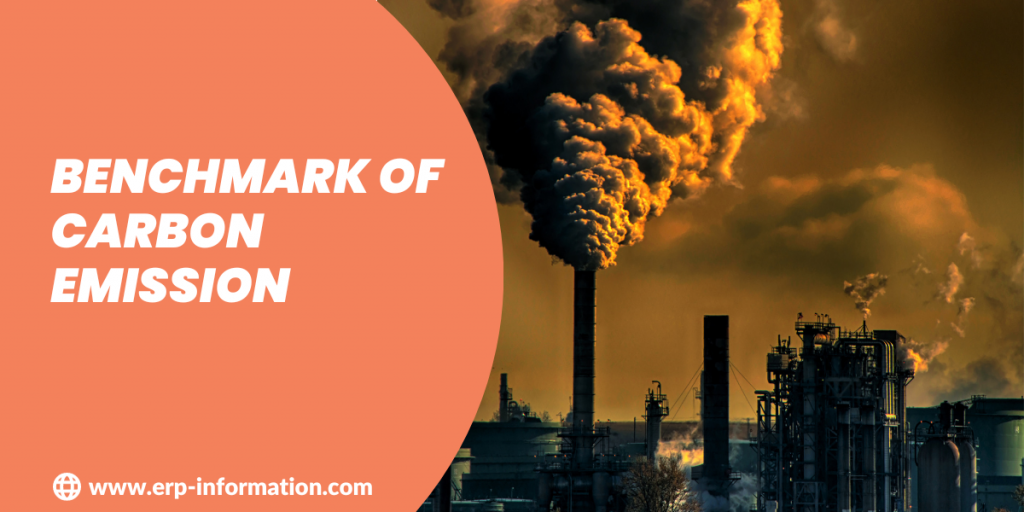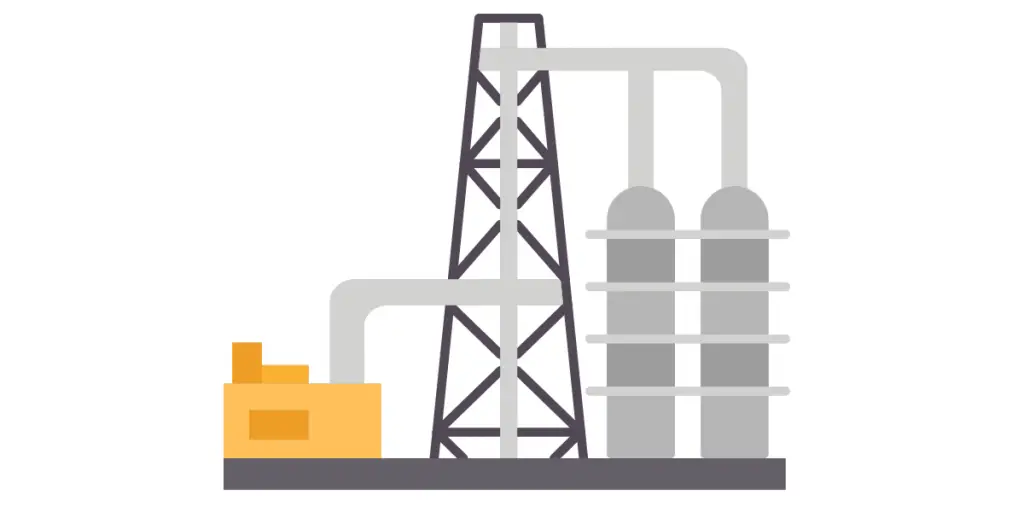In the revolutionary world, all industries are competitively producing new products with new inventions. But all need to take care of the earth simultaneously and control their carbon emission production to the earth.
Every industry, from manufacturing and energy to transportation and agriculture, plays a unique role in the carbon emissions puzzle. Companies turn to carbon emission benchmarks to gauge the effectiveness of their sustainability efforts.
These benchmarks are the yardsticks against which businesses measure their carbon footprint, helping them make informed decisions to reduce their environmental impact.
This article takes you into the world of carbon emission benchmarks, demystifying the concept in simple terms and exploring specific benchmarks across 6 different industries such as the transportation industry, cement industry, oil and gas industry, iron and steel industry, electricity generation, and food and agriculture industry.
By the end, you’ll have a clearer picture of how different sectors are faring in their carbon reduction journey, and how benchmarking can guide them toward a greener future.
Evaluate carbon emissions using our Carbon emissions calculator online
Benchmark of Carbon Emission
Here we are listing the Benchmark of Carbon Emission in Different Industries
1. Transportation Industry
The transport sector heavily depends on fossil fuels more than any other industry. In 2020, COVID-19 regulations caused a temporary drop in emissions from transportation, but the demand for transportation has surged in 2021 and is expected to keep rising.
The transport industry plays a vital role in our efforts to reduce carbon emissions and transition to sustainable energy sources, which are essential to meet the objectives of the Paris Agreement and the Sustainable Development Goals (SDGs).
Achieving the ambitious target of limiting global warming to well below 1.5°C requires a profound and transformative shift within the transport sector.
From 2021 to 2022, global transport-related carbon dioxide (CO2) emissions increased by 3%, mainly due to the rebound in passenger and cargo transport following the COVID-19 pandemic. The transport sector has experienced an average annual growth rate of 1.7% in emissions from 1990 to 2022, closely following the industrial sector, which also grew at a similar rate.
To achieve the Net Zero Emissions (NZE) by 2050 Scenario, the transport sector must significantly reduce its emissions by more than 3% annually until 2030. In 2021, worldwide greenhouse gas emissions totaled 40.8 billion metric tons (BMT), with the United States contributing 6.4 BMT, primarily consisting of 80% CO2 emissions.
Notably, 92% of U.S. CO2 emissions, amounting to 4.6 BMT, were generated from fossil fuel consumption for energy production. The remaining 8% stemmed from non-energy processes in industrial, agricultural, and waste management sectors.
In 2021, the transportation sector in the United States alone accounted for 1.7 BMT of CO2 emissions, making it the largest contributor. The electric power sector followed as the second-largest source with 1.5 BMT of CO2 emissions. Additional energy-related sources in the industrial, residential, and commercial sectors contributed a combined 1.4 BMT.
These statistics emphasize the pressing need for stringent regulations, fiscal incentives, and substantial investments in low and zero-emission infrastructure to achieve the necessary reductions in transport emissions, as well as to address the broader challenge of reducing greenhouse gas emissions on a global scale.
Benchmark
WBA’s (Worls Benchmark Alliance) Climate and Energy Benchmark is a tool that assesses and ranks companies with high carbon emissions. It looks at various aspects that are crucial for reducing emissions and transitioning to cleaner energy.
This benchmark not only checks what companies are doing right now but also looks at their future plans to reduce carbon emissions. It also evaluates how well their efforts align with the goals of the Paris Agreement, which aims to combat climate change.
2. Cement Industry
Cement is an important material used in construction, but it has a big environmental problem. When we make cement, a process involving limestone releases a lot of carbon dioxide (CO2), which is a major contributor to climate change.
In the quest for carbon neutrality, the cement industry faces challenges due to its high energy consumption and carbon emissions.
To understand how this affects cement companies, a model was created with three parts
- Demand and production
- Economic efficiency
- Carbon emissions and trading
It measured a company’s competitiveness based on this model.
Some survey analyses that cement emission is around 7-8 % of the world’s total carbon emissions. This roughly translates to several hundred million metric tons of CO2 being emitted by the cement industry each year.
Approximate emission is around 2.5 to 3 billion tonnes per year. However, specific annual emission rates can vary from year to year and are influenced by factors such as economic conditions, construction activity, and the adoption of cleaner technologies.
Benchmark
First, the benchmark must outline a detailed time path for carbon emissions that aligns with global climate targets, specifically targeting a limit of 1.5°C warming.
This plan should be consistent with the associated carbon budget and encompass the entire life cycle of cement production, spanning from raw material extraction to manufacturing and transportation.
The benchmark also requires a comprehensive breakdown of economy-wide emissions specific to the cement industry. This involves identifying crucial sectors within the industry, such as raw material extraction, clinker production, cement manufacturing, and transportation. Quantifying the emissions from each sector forms the basis for sectoral emissions intensity.
To calculate sectoral emissions intensity, the benchmark must divide emissions from each key sector by the corresponding economic activity or physical production. This calculation should highlight emissions intensity per unit of cement produced, taking into account factors like energy efficiency, alternative fuels, and technological advancements.
Consistent production estimates are vital for the benchmark, requiring reliable projections for the time path of physical production or economic activity within the cement industry.
These estimates must consider influences such as market demand, technological advancements, and policy changes, ensuring alignment with the overall carbon emission time path and contributing to emissions reduction over time.
In terms of innovation and technology integration, the benchmark should incorporate strategies for implementing innovative technologies and practices to reduce emissions in the cement industry. This includes exploring options like carbon capture and storage (CCS), alternative raw materials, and sustainable production processes.
3. Oil and Gas Industry
To align with the International Energy Agency’s Net Zero Emissions by 2050 approximately 80% of emissions in the oil and gas sector originate from burning oil and gas products, making it clear that the sector’s primary path toward a sustainable future involves phasing out fossil fuels.
The oil and gas industry is a substantial contributor to global greenhouse gas emissions, accounting for about 15% of all energy-related emissions, equivalent to 5.1 billion tons.
Scenario, emissions from these activities must decrease by 50% by the end of this decade, resulting in a 60% reduction by 2030. Such action is vital to limit global temperature increases to the crucial 1.5°C target.
However, oil and gas companies seem reluctant to curtail their expansion efforts, and many major companies are on track to exhaust their carbon budgets by 2036.
These companies in the oil and gas sector decided to spend a massive amount of half a trillion dollars on new drilling and extraction projects. This is a problem because it goes against the pressing need to move away from fossil fuels for the sake of the environment.
What’s even more concerning is that the 81 companies involved in extracting oil and gas are planning to increase their oil production by 9% from 2021, and this increase is expected to reach its highest point in 2028.
This means they are not slowing down their oil production, which is contributing to carbon emissions and climate change.
This situation underscores a significant challenge in the fight against climate change. It’s imperative for the oil and gas industry to swiftly embrace cleaner energy solutions and reduce their emissions.
Benchmark
Companies within the oil and gas sector have to play a pivotal role in this effort by striving to reduce their scope 1 and 2 emissions during this decisive decade. Companies are posing a significant challenge to achieving the imperative global warming limit of 1.5°C.
To address this urgency, companies must deploy the five key levers outlined by the International Energy Agency (IEA).
The IEA’s five key levers
- Tackling methane emissions
- Eliminating non-emergency flaring
- Electrifying facilities
- Implementing CCUS
- Embracing green hydrogen
Provide a comprehensive roadmap for companies to align with global climate goals and navigate this critical decade responsibly. Companies should build upon existing advancements and persist in enhancing their due diligence processes related to human rights. Compared to other sectors evaluated in WBA’s Climate and Energy Benchmark, the oil and gas industry demonstrates alignment with, or in some cases surpasses, human rights due diligence standards.
4. Iron and Steel Industry
The iron and steel industry is a big player in energy consumption, using about 7% of the world’s energy, and is responsible for roughly 7–9% of global greenhouse gas emissions.
To tackle climate change, it’s crucial to decarbonize this industry, making it more sustainable. A detailed review, examining over 1.6 million pieces of literature, delves into the decarbonization efforts.
Within this industry, the iron and steel sector leads in both CO2 emissions and energy consumption among heavy industries.
Annually, it directly contributes 2.6 gigatonnes of carbon dioxide, accounting for 7% of the global total from the energy system—more than emissions from all road freight combined. Steel production heavily relies on coal, constituting 75% of its energy demand, contributing to its significant carbon footprint.
While the steel sector has doubled its production globally from 2000 to 2020, it also stands as the largest industrial contributor to global greenhouse gas emissions, making up 7% of the total and 11% of global carbon dioxide emissions. China plays a substantial role, accounting for over half of the world’s steel production in 2020.
Despite this, the current trajectory indicates an increase in energy use and emissions in the steel industry, mainly due to rising global demand for steel, particularly in developing countries.
This outpaces the incremental improvements in energy efficiency and emissions intensity in steel production. To address this, the review identifies 86 potentially transformative technologies, emphasizing the need for urgent and effective measures to decarbonize the iron and steel industry.
Benchmark
Analyzing energy and CO2 emissions intensities in the steel industry among major steel-producing nations. Varying compositions and production methods make a single intensity value unsuitable for gauging overall steel industry efficiency.
Iron and steel producers can significantly cut energy consumption and greenhouse gas emissions by embracing innovation, deploying low-carbon technology, and enhancing resource efficiency.
Examining challenges and opportunities and analyzing crucial technologies and processes for achieving significant CO2 emission reductions in the sector.
5. Electricity Generation

The electric utilities sector has been a leader in adopting low-carbon technologies, paving the way for other industries to follow suit. Despite these advancements, it’s falling short of the 1.5°C goal.
According to WBA’s benchmark, 70% of assessed companies in this sector are predicted to perform even worse in terms of low-carbon practices soon.
The concerning part is that 98% of these companies are expected to surpass their carbon budgets by 2035 due to continued reliance on fossil fuels for electricity generation.
While the International Renewable Energy Agency (IRENA) envisions renewables making up 91% of electricity generation by 2050, the current reality is different.
In 2021, the electricity sector contributed over one-third of global energy-related emissions, reaching 13 gigatonnes of carbon dioxide.
To make significant strides in reducing CO2 emissions, there’s a critical need for the rapid expansion of clean electricity. Various power generation methods have different emissions levels; fossil fuel technologies emit more during combustion, whereas renewables like onshore wind have lower emissions.
It’s essential to consider indirect emissions from the infrastructure’s embodied carbon, especially given the variability in renewable technologies.
Lifecycle analyses, like those from the United Nations Economic Commission for Europe (UNECE), play an important role in evaluating emissions intensity across different technologies. A comprehensive approach, considering the entire lifecycle from production to disposal, is vital for electricity decarbonization.
As countries strive for net-zero targets, every aspect of the electricity value chain demands attention. Recognizing renewables as pivotal in the energy transition, understanding and optimizing their entire lifecycle is crucial for a sustainable and cleaner energy future.
Benchmark
Companies must elevate their ambitions and effectively implement climate transition plans; otherwise, it poses a severe threat to both their businesses and our broader climate mitigation endeavors.
The concerning reality that only 8 out of 50 companies are presently investing sufficiently in low-carbon technology to align with a 1.5°C warming scenario raises a warning signal for the entire industry.
As policymakers contemplate the timing and methodology for ensuring companies align their transition plans with the 1.5°C target, the latest benchmarks reaffirm that achieving planetary carbon neutrality cannot depend solely on private sector commitments.
Mandates such as the European Union’s Taxonomy, informed decisions by the financial sector, and pressure from civil society should expedite the implementation of tangible transition plans. – Romain Poivet, Coordinator of the ACT Initiative at ADEME.
6. Food and Agriculture

The Food and Agriculture benchmarks assess the sustainability performance of the 350 most impactful companies, covering their environmental, nutritional, and social impact from farm to fork.
Compared to the 2021 benchmark tied to the UN Food Systems Summit, the 2023 iteration reveals changes in the top 25, with nine new leading companies, including two from the Global South within the top 10. While more companies are cutting their carbon footprint and embracing regenerative agriculture, there’s a notable gap in prioritizing people in this transition.
Surprisingly, 35% of the influential companies, totaling 122, scored 10/100 or lower, indicating a lack of recognition regarding their role in fostering sustainable food systems.
This emphasizes the need to hold these companies accountable to ensure the entire sector aligns with the Sustainable Development Goals. It’s not just about environmental impact but also about putting people at the heart of the transition for a truly sustainable and inclusive food future.
Benchmark
The objective of the Food and Agriculture Benchmark is to furnish stakeholders with a tool to ensure accountability within the sector, emphasizing its responsibility to foster healthier, more sustainable, and equitable food systems.
Closing the income gaps for farmers is imperative for companies. Health prioritization is a must for food companies. While more companies are adopting climate targets, the pace of progress is sluggish.
Regenerative agriculture is gaining ground, though challenges persist in input use. The absence of corporate accountability acts as a barrier to substantial and meaningful change.
Conclusion
The ultimate goal of this benchmark is to promote transparency and corporate responsibility through comprehensive assessments, encouraging companies to make meaningful commitments and take action to address climate change and its social impacts.
Establishing monitoring and reporting mechanisms is important for tracking progress toward benchmark goals. This involves incorporating key performance indicators (KPIs) that reflect the industry’s adherence to the specified carbon emission time path.
Stakeholder engagement is integral to the benchmark, necessitating the involvement of industry representatives, environmental groups, and policymakers. This benchmark takes into account how companies contribute to a fair and just transition as outlined in the Sustainable Development Goals.




